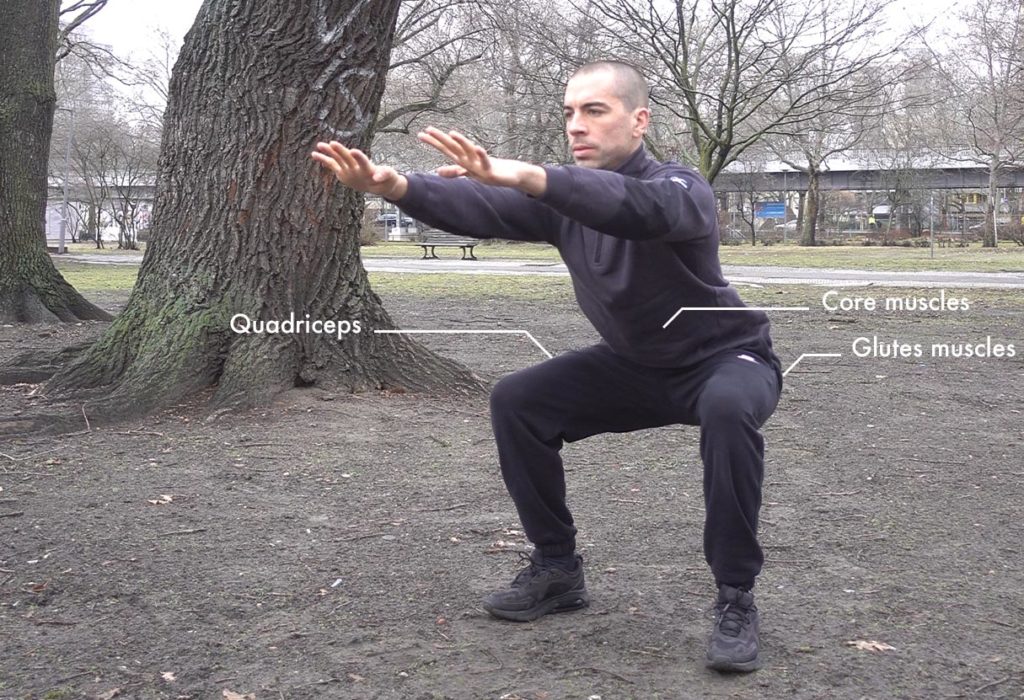This website uses cookies so that we can provide you with the best user experience possible. Cookie information is stored in your browser and performs functions such as recognising you when you return to our website and helping our team to understand which sections of the website you find most interesting and useful.

“WAY TO” 002 – SQUAT




The squat is one of the best-known movements in sports training. It is simple to set up, requires no equipment, can therefore be performed anywhere, and the difficulty of the exercise can be easily adapted to all levels of strength of the different athletes who want to perform it.
What muscles do you train when you do a squat?
Here is an illustration showing the different muscles trained during the realization of “classic” squats as discussed in this post
How to perform a proper squat?
1- Start standing, with a straight back and stretched legs, feet shoulder-width apart with the toes of the feet slightly outward, in line with the knees.
2- Descend slowly by placing the body weight on the heels, bending your legs, bringing your buttocks backward (as if you wanted to sit on a chair), the back remaining “straight” (according to its natural lumbar curvature), and raising your arms forward (hands level with the shoulders) to keep a good balance, until the thighs are parallel to the floor.
3- In the low position, the thighs are parallel to the floor (as much as possible according to your ankle or hip mobility, or hamstring flexibility), the knees are in line with the feet (be careful not to pitch your upper body forward, if that happen, try to place a 10 cm object under the heels and perform the squat again).
4- Inhale before going down or while going down, exhale while going back up to the starting position, concentrate on driving the chest out, bringing the hips up and forward
5- Tighten the buttocks and the abdominal strap in the up position, and bring the hips slightly forward
If you are a beginner, and you train alone, don’t hesitate to film yourself to check that your knees maintain the right position and that your back remains straight (keeping the natural curvature). If you feel that you are not maintaining the correct shape as described above, stop the exercise immediately and correct the shape, as it becomes counterproductive and dangerous. When this is not possible because the variation you have chosen is too difficult for you, move on to an easier variation described below.
How can you increase or decrease the difficulty of your squats depending on your strength?
It is possible and recommended adapting the difficulty of the exercise to your level, the main thing being to keep a good execution form when doing the squats, in order to progress efficiently and healthily.
To do this, it exercises different variations of the exercise, which are easier depending on the loads added to the exercise, or the placement of your feet.
Different variations of squats:
There are numerous squat variations, which will work different muscles depending on the placement of the feet, or the load added.
– Squat with a dumbbell held between the legs: This variation uses the same muscles, making the exercise more difficult with the weight held between the legs.
– Squat with a high bar placed on the front of the shoulders: The bar will be placed on the top of the pectorals and on the top of the shoulders (deltoid). The bar placed this way does not allow any bending of the chest forward, so the back will always be straight.
– Squat with fixed bar and spread legs: This movement is performed in the same way as the squat without additional load. Spreading the feet will allow intense work on the inner thighs (adductors).
How do you make progress on the squats?
As you progress in the practice of squats, be aware that you will eventually reach a plateau. Don’t be discouraged when this happens: it is a normal and inevitable phenomenon.
Here’s how: suppose, for example, you have done up to 20 “normal” squats in a row and, despite your best efforts, you can’t make 21. The next time you practice, move to a more difficult variation of the exercise by adding more weight, as described above. You can then challenge your body differently, and eventually, you will be able to progress through this stage to the next one.
If you have any questions, don’t hesitate to contact me and I will be happy to answer them.
